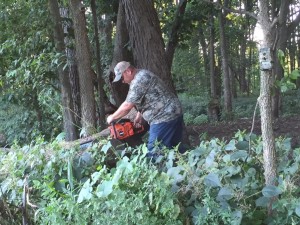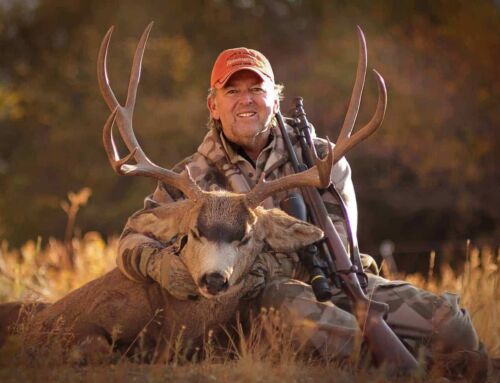 Dr. Grant Woods, one of America’s top whitetail biologists and habitat specialists, says that many hunters make deer management out to be way too complicated, like it is Advanced Trig or something.
Dr. Grant Woods, one of America’s top whitetail biologists and habitat specialists, says that many hunters make deer management out to be way too complicated, like it is Advanced Trig or something.
“It’s simple math,” he says. “If you plant some food and make some improvements to your land, you can go from having maybe 50 percent deer that live on your property and 50 percent that just travel through, to maybe 80 percent that live on your land and 20 percent that are transient.”
In other words, you might increase the number of does and bucks that live in core areas on your spot by some 30 percent, which naturally will lead to more deer sightings and more buck encounters.
The great thing is that you don’t need 1,000 acres or a huge bankroll to do it. Fifty to maybe 200 acres and a working-man’s salary will do. Spend a few weekends and a few hundred bucks for gas, seed, fertilizer and the like, and get to work. The improvements you make now will attract more deer to your land this fall. And here’s the best part. Stick with your plan and build upon it for the next three or four years, and you’ll see noticeably more bucks. It’s as simple as that. Here are a few practical and cost-efficient things you can do.
Plant Some Strips
One time I hunted with three guys who pooled their funds and purchased a 300-acre farm in southern Illinois. The tract has a good amount of timber and CRP fields and planted pines, so the cover for deer is there. They lease out the farm’s tillable acres to a farmer who rotates corn and soybeans each year, so the major food sources are there.
Over the past three years, Frank, Doug and Ridley have spent several weekends each off-season making their farm even better. They put in a couple of ½- to 1-acre linear food plots each year; initially, they had to do some dozing, but where possible, they selected pasture edges and old fields for the plots to keep the work and cost down. Mostly they have sowed Imperial Whitetail clover (30-35 percent protein and low-maintenance) in the strips.
These strips are strategically located back off crop fields and adjacent to thick cover. They are prime staging areas for does and bucks, and the long edges and short corners are natural travel spots for bucks, especially in the rut. I counted dozens of rubs, some thick as my calf, and scrapes on the strip edges when I was out hunting. The guys have hung multiple lock-on stands around the strips that they can hunt on various winds, both morning and evening, and that is where they enjoy their best bowhunting.
“When we started hunting the property three years ago we’d see some deer from the edge of the corn fields and in the draws back in the woods, but the buck sightings were hit and miss,” Ridley told me. “Now we hunt our plot stands primarily in October and November and see 10 or more does a sit, and often a few bucks. Sometimes a 140- to 150-class buck.”
Going into their fourth year on the farm, the guys continue to build upon the success of their simple but effective land plan. They put in a new small plot where and when practical. They are experimenting with plantings. On some ends of their establish strips they are sowing annual attractants; on other ends, oats, brassicas and other late-season deer forage. That is the beauty of an on-going plan. The longer you do it and refine it, the less work and better the results.
Do Some Strategic Mowing
My buddy Jim Crumley, who created Trebark camouflage back in 1980, has a passion: managing whitetails on his 296-acre farm along Virginia’s James River. When Jim began his obsession years ago, he eagerly read all the books and watched all the videos on deer management. The more he has worked and gotten his hands dirty over the years, the simpler his plan has become.
“I’ve found that the easier and more cost-effective you make your plan, the more you’ll stick with it and the harder you’ll work,” he says.
Jim does most of his work with a tractor and a bush-hog. “If you’ve got a pasture or weed field on your property, one of the best things you can do is go in and mow 5 or 6 strips through the weeds, maybe 100 yards long and 20 yards wide,” he says. “Leave larger tall strips of vegetation between the mowed rows.” This creates lots of diversity and edge for deer, and often they will come to walk the rows.”
Jim has several bow stands hung in trees where a mowed strip intersects a wood line.
Also, when fall rains come in bow season, succulent green forbs pop up in the mowed strips, and deer love this instant food source. You’ve created yet another food source to hunt, an out-of-the-way honey hole where you might shoot a buck.
While Jim relies mostly on mowing, he does disc and plant some of the strips if he feels the need more deer feed in particular area. When he plants, it is good old ladino clover, which is a low-maintenance, high-quality and time-tested perennial with about 25% protein. “Once planted, the clover can last for 5 years and it can be easily over-seeded,” Jim notes. “It is easy to plant and maintain in my plots and strips, and that is important since I’m a one-man show.”
Create Some Cover
 Big bucks, like big bass, are drawn to structure. If you don’t have much cover in some parts of your woods, you and your buddies can go in with chainsaws and create pockets of structure that will attract and hide deer. NOTE: Be careful and wear goggles and chaps. If you lease or just have permission to hunt the ground, you need the owner’s approval before you cut a single tree.
Big bucks, like big bass, are drawn to structure. If you don’t have much cover in some parts of your woods, you and your buddies can go in with chainsaws and create pockets of structure that will attract and hide deer. NOTE: Be careful and wear goggles and chaps. If you lease or just have permission to hunt the ground, you need the owner’s approval before you cut a single tree.
It’s not as much work as it sounds. Aim to scatter a few linear cuts 50 or 60 yards wide and long through the woods. Look for low-quality, 3- to 6-inch “trash trees” that have little or now value to wildlife; cut them low but don’t sever from the stumps. Just cut until the tops topple to the ground and you’ll have “living brush piles.” The trees will live for a year or maybe two and provide accessible browse for deer, and the fallen tops will provide excellent travel and staging cover for bucks.
Summary: Let’s see, you’ll need a tractor, ATV, a few implements, some bags of seed, a chainsaw, a buddy or two and a willingness to get your hands dirty for a few weekends this summer. It’s worth it for the better hunting you have in three or four months.





